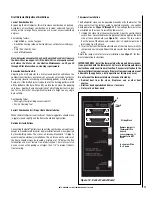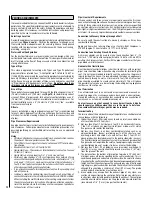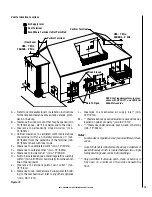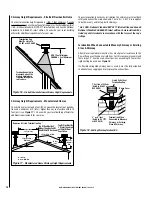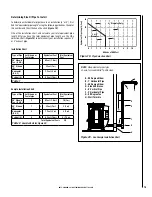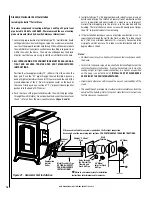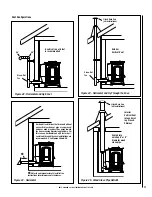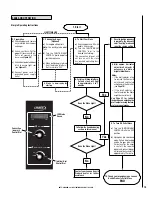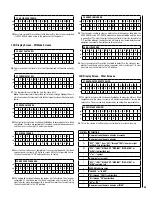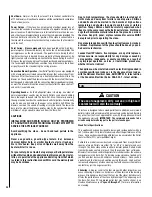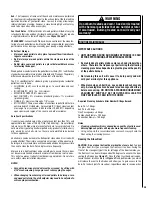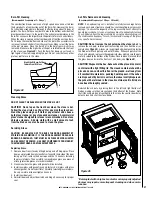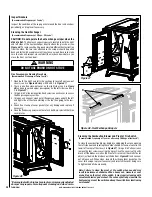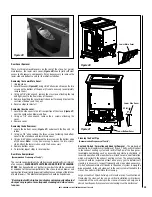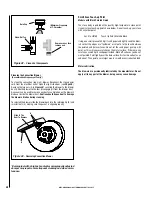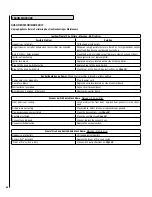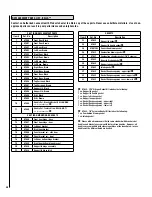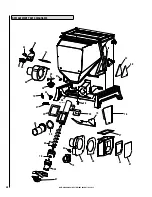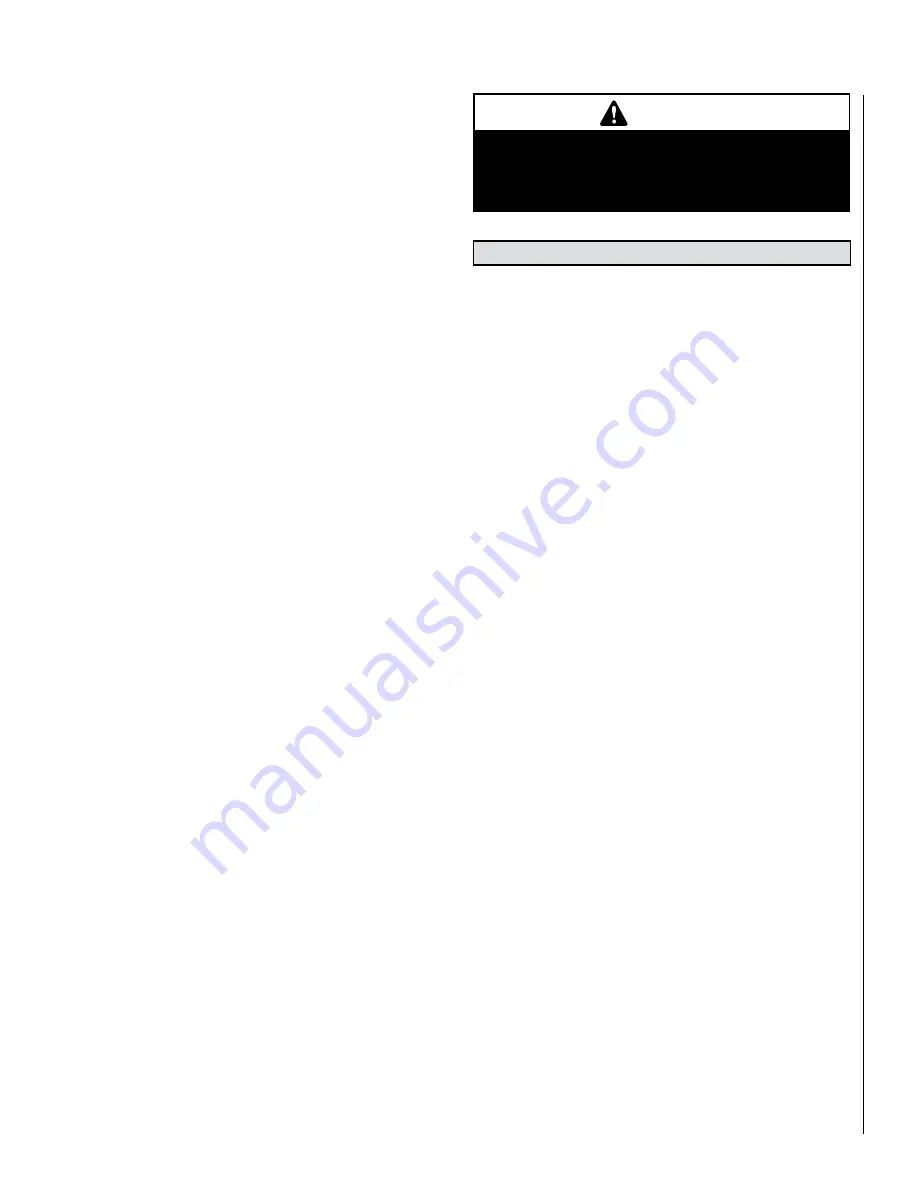
25
WARNING
Do not burn treated seed corn! Seed corn is treated
with chemical pesticides that are harmful or fatal
if swallowed. Burning treated corn will void your
warranty!
Ash -
The frequency of removal of the ash and maintenance performed
on the stove is directly proportional to the ash content of the fuel and the
operation duration of your pellet stove. Low ash fuel may allow longer
intervals between cleaning, however, a stove burning high ash fuel may
need to be cleaned as often as everyday.
Fuel Feed Rates - Different brands of wood pellets will feed at varying
rates due to their size and density (length and diameter). This may require
a slight adjustment in the draft adjuster (see
Pages 10 and 11).
PLEASE NOTE
: Lennox Hearth Products has no control over the manufac-
turing of wood pellet fuel and will not be held responsible for poor stove
performance or any damage caused by poor quality wood pellet fuels.
Pellet Fuel Storage -
• Store your wood pellets in a dry place to prevent them from absorb-
ing excess moisture.
• Do Not store your wood pellets within the clearance zone of the
stove.
• Do Not store your wood pellets in a place that would block access
to refueling the hopper.
Wood pellets manufactured to the pellet fuels institute (P.F.I.) certification
standard are available in two grades, Standard and Premium. The primary
difference between the two is the ash content of the pellets.
The P.F.I. specification for standard grade & premium grade residential
pellet fuel is as follows:
• CHLORIDES (Salt): Less than 300 p.p.m. to avoid stove and vent
rusting.
• BULK DENSITY: 40 lb. / Cu. Ft. minimum
• MOISTURE CONTENT: 8% maximum
• ASH CONTENT: < 2% maximum (standard grade) < 1% maximum
(premium grade)
• FINES: 0.5% maximum through a 1/8” screen
• BTU CONTENT: There are a number of variations in pellet fuels that are
not included in PFI standards. For example, BTU (heat value) content
may range from just under 8,000 to almost 9,000 BTU, depending
upon species and region of the country and other variables.
Corn Fuel Specifications
Use only clean-shelled corn with a moisture content less than 15% and
approximate fuel value of 7000 BTU/lb (16,200 kJ/kg). Do not attempt
to burn corn with higher moisture content or burn lesser grade fuels. Do
not burn other types of agricultural pellets or by-products (alfalfa, cherry
pits, olive pits, nut shells, etc.) as they are not permitted to be burned
in these appliances.
Shelled corn can be burned in the Bella pellet stove when it is mixed with
wood pellet fuel. The mixture can contain a maximum of 50 percent corn.
Burning corn may create more ash than wood pellets and may necessitate
the need to clean the Burn-Pot and glass more frequently.
Store corn in a tight container and use methods to ensure the corn does
not become rain soaked or absorb moisture from damp or wet sources.
This will also prevent rodents from becoming a problem. Do not store
corn within stove installation clearances.
NOTES:
• Corn with excessive grain dust must be screened, by sifting with
3/16" mesh screening. Large pieces of cob may plug the auger.
• When changing from burning all wood pellets to burning a corn
and wood pellet mix, the draft adjuster may need to be adjusted to
achieve proper combustion.
ROUTINE MAINTENANCE
IMPORTANT CAUTIONS:
• UNPLUG POWER CORD AND ENSURE APPLIANCE IS COLD
BEFORE PERFORMING ANY MAINTENANCE WORK.
• Some brands of pellets produce more ash and clinkers than
others. Therefore the frequency of performing the following
cleaning procedures depends to a great degree on the quality
of the pellets burned.
• Not cleaning this unit will cause it to burn poorly and will
void your warranty for this appliance.
• When removing ash build-up, use an approved ash vacuum
only. A cleaning brush can be used to loosen any ash build-up
before vacuuming. DO NOT USE A STANDARD HOUSEHOLD
VACUUM OR “SHOP VAC” AS THE FILTERS WILL LEAK THE
FINE PARTICLES OF ASH INTO THE HOME.
Required Cleaning Schedule After Number Of Bags Burned:
Burn-Pot = 10 bags
Ash Pots = 20 bags
Flue Passageways = 50 bags
Combustion Blower = 100 bags
Convection Blower = 100 bags
Notes
• Cleaning schedule will vary depending on quality of pellets used.
Burning high ash pellets will require more frequent cleaning.
• Using a drop cloth is recommended as some ash may spill onto the
floor during the cleaning process
.
Opening the Glass Door
CAUTION: Do not open the front door when the stove is hot. To open
the glass door, first you must open the front cast iron door. Facing the
front of the stove gently pull the far left edge of the door towards you,
the front cast iron door will open about 90 degrees to uncover the door
sealing the firebox (see
Figure 31)
. Once the front cast iron door is open,
locate the door latch handle (B in
Figure 31)
and pull towards you which
will release the seal to the firebox and allow you to gain access to the
Burn-Pot and ash pots. To close door, repeat these steps in reverse order.
Summary of Contents for BELLA
Page 43: ...43 NOTES ...

